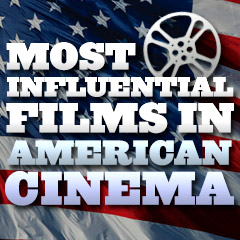Most Influential, Significant
and Important Films in American Cinema
(chronological by time period and film title)
|
|
Title Screen
|
Film Title/Year/Director/Length/Studio,
Descriptions of Influence/Significance |
Poster
|
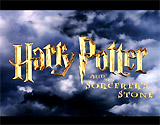
|
Harry Potter and the Sorcerer's
Stone (2001)
d. Chris Columbus, 152/159 minutes, Warner Bros./Heyday Films/1492 Pictures
- All of the films in this incredible fantasy/adventure
film series were based upon adaptations of the J. K. Rowling books.
The first film was based upon Rowling's 1997 novel Harry Potter
and the Philosopher's Stone. With tie-ins
to the best-selling series of children's books, after the rights
to the books were purchased in 1997 (the first four books were
available before the first screen adaptation), the films were guaranteed
a built-in fan base (of youth and adults alike).
- The seven-book series sold about 500 million
copies worldwide ($400 million worth) and was translated into
approximately 80 languages. The last four books set records as
the fastest-selling books in history. The imaginative
books revived for young people the simple joy of reading, and ingrained
the stories in global popular culture.
- The Potter films were on track to be one
of the biggest, longest, most successful (and lucrative), most
loved, and best-received film franchises of all time in their ten
year run with eight movies (at a total of $2.39 billion - domestic,
and $7.73 billion - worldwide), known by the buzz-word "Pottermania."
- With a production budget of $125 million, its box-office
was immense, $317.5 million (domestic) and $975 million (worldwide),
and it was the highest grossing film of 2001, just surpassing
The
Lord of the Rings: The Fellowship of the Ring (2001) at
$313 million. Harry Potter and the Sorcerer's
Stone (2001) was finally surpassed as the single, # 1 highest
(domestic) grossing film of the franchise by the last film,
Harry
Potter and the Deathly Hallows, Part 2 (2011).
- The Potter films revived the once lost
genre of children's fantasy, with three young unknowns in the leads
who played their roles throughout the entire series. The film series
solidified the idea that multi-movie franchises should have the
same basic cast - much different from the pattern followed
by other major franchises (the James
Bond films, the Star Wars films, etc.).
- The three main cast members, Daniel Radcliffe, Emma
Watson, and Rupert Grint in the three main roles, remained as the
same trio throughout the entire franchise until "Harry
Potter and the Deathly Hallows Part 2" debuted in 2011. They
were joined by a variety of talented and fascinating supporting
characters, innovative visual effects, and great production design.
There have been many attempts to capitalize on the series' success
- with other copycats and wannabees.
- In
all of the Harry Potter films, the title character - orphaned, bespectacled
Harry Potter (Daniel Radcliffe) with a lightning bolt-shaped scar
on his forehead, battled against darkly evil cruel wizard Lord
Voldemort (played by various characters in the films, although
usually Ralph Fiennes) or He-Who-Must-Not-Be-Named, who had killed
Harry's parents. It was a classic tale of good vs. evil.
- This film became the foundation for the same literature-to-screen
adaptations pattern followed by other fantasy book series: including The
Lord of the Rings, Twilight and The Hunger Games franchises. Other extended film franchises have followed Potter's
lead by splitting the original literary source into installments
(Harry
Potter and the Deathly Hallows, Parts 1 and 2): Peter Jackson's
The Hobbit, The Hunger Games: Mockingjay: Parts 1 and
2, and Twilight: Breaking Dawn, Parts 1 and 2.
- [Note: A whole new series of three films set in
the Harry Potter Cinematic Universe were also a byproduct. The
spin-offs and prequels to the Harry Potter film series were
known as the Fantastic Beasts franchise: Fantastic Beasts
and Where to Find Them (2016), Fantastic Beasts: The Crimes
of Grindelwald (2018), and a third film due in 2021.]
- Billions in revenue were generated by merchandising
deals (books, shirts, posters, toys, games, and much more). In
fact, the franchise has taken in an average of nearly $1 billion
every year for more than a decade. The film
series became the basis for Universal Studios' theme park attraction.
- Some have suggested that J.K. Rowling’s adapted
filmic tales influenced and shaped the political
views of the millennials - a generation of book-reading,
faithful film-attending Potter fans who developed greater
tolerance and acceptance of personal differences, less authoritarianism,
anti-violence sentiments, and more support for equality.
|
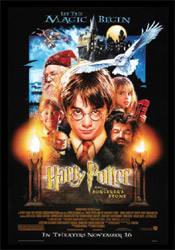
|
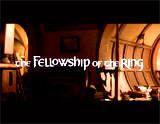
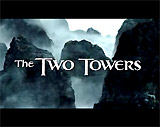
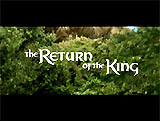
|
The Lord of the
Rings Trilogy (2001-2003, NZ/US)
d. Peter Jackson, 178/179/201 minutes, New Line Cinema/WingNut
Films/Saul Zaentz Company
- Peter Jackson's successful fantasy adventure-epic
about witches and wizards - The
Lord of the Rings: The Fellowship of the Ring (2001) -
the first of three films - was derived from J.R.R. Tolkien's fantasy
tale of Middle Earth with Hobbits, dwarves, and elves. Jackson
would go on to complete a nine-hour trilogy in the next few years,
with two more films: The
Lord of the Rings: The Two Towers (2002),
and The
Lord of the Rings: The Return of the King (2003). It was
the new generation's epic fantasy trilogy, a new 'Star Wars' for
an entire new group of movie-goers and film-makers, featuring an
ensemble cast.
- Fantasy films in the past, such as The Dark Crystal
(1982), The NeverEnding Story (1984), and Labyrinth (1986)
were mostly youth-oriented and only on a small scale. The LOTR
films were epic - they created a new interest in the fantasy film
genre, especially after the series won so many
Academy Awards. In total, the three films won 17 out of 30 total
Academy Award nominations. The final film in the trilogy, The
Return of the King (2003), won an unprecedented eleven Oscars
- all of the awards for it was nominated. It
became only the second sequel to win the Oscar for Best Picture.
Fantasy content would afterwards be taken more seriously as big-screen
epic entertainment, and not regarded as solely for children or
for animated films.
- Each film in the
trilogy garnered more support - and also led to a whole new offshoot.
A three part trilogy of Hobbit films (from 2012-2014), adapted from J.R.R. Tolkien's beloved 1937 fantasy
novel, was created as a prequel - set decades before the events
of The Lord of the Rings trilogy.
- The first film was a tremendous gamble by director
Peter Jackson, and its massive scale, non-linear story and sprawling
scope were considered unfilmable. Back in the year 2000, it was
risky for studios to fund more than one movie - fearing that the
first one might flop. As a money-saving gesture, Jackson filmed
the entire LOTR story as one film over 16 months in New Zealand
- then divided it into three installments. This strategy transformed
long-term franchise planning. Simultaneous movie productions and
commitments to multi-movie deals became more commonplace. Similar
future fantasy literary works would be optioned and planned, such
as The
Hunger Games, Twilight, and even HBO's Game of Thrones (cable
tv), etc.
- The films blended revolutionary, state-of-the-art
computer animation (i.e., the incredibly realistic digital movie
character of Gollum created by motion-capture), computer-controlled
cameras, visual effects, visual trickery, prosthetics and very
large, highly-detailed miniature models (known as bigatures) to
create an immersive vision of Middle Earth. The Weta Workshop in
New Zealand produced many of the sets, costumes, armor, weapons,
creatures and miniatures.
- CGI motion-capture performances, following Andy
Serkis' remarkable portrayal of the virtual character of Gollum,
included Caesar in
Rise of the Planet of the Apes (2011) (coincidentally also
played by Andy Serkis), and the Hulk in The Avengers (2012).
Jar Jar Binks in Star Wars: Episode I - The Phantom Menace (1999) was
not even in the same league.
- For the huge battle scenes in The
Lord of the Rings trilogy, the filmmakers created
MASSIVE, an AI computer program that generated crowds of artificially
intelligent (CGI) customizable characters that could be programmed
with specific sets of actions - producing more realism for the body
movements of thousands of men, horses, Orcs and other combatants.
- Beyond the theatrical cinematic experience, the
original trilogy was made available as an Extended Edition on
DVD, with all the formerly-deleted scenes remaining intact - for
a full vision of Tokien's entire work. Its extensive multi-disc
box-set with 'making-of' featurettes, and 26 hours of additional
footage, set a major benchmark for home video box-sets.
- As a result of the franchise's popularity and importance
to New Zealand, tourism to the country increased. Air
New Zealand had two Airbus A320 jets decorated in a Tolkienesque
theme, and their safety video was Middle Earth-themed.
|
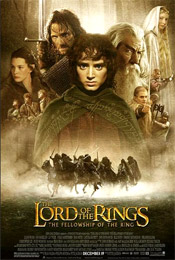
|
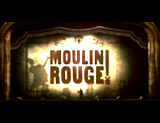
|
Moulin Rouge! (2001)
d. Baz Luhrmann, 127 minutes, 20th Century Fox
- Australian writer/director Baz Luhrmann's hit summer
musical resurrected, reinvented or heralded the return of the Hollywood
musical - a genre that was almost dead at the start of the 2000s
decade. It created a desire to look for further film musical opportunities
for the big screen, that also could include well-known rock-centric
pop musical hits and MTV-video-styled filming.
- The dazzlingly colorful, whirling and kinetic modern musical with
stunning Oscar-winning costuming was set in 1900 Paris, and told
a story of tragic love.
- The fantasy film innovatively reinvigorated the
stale romantic-musical format, by featuring a pop-music "jukebox"
soundtrack. The interesting romantic plotline told about the development
of a doomed love between poor and struggling English poet/writer
Christian (Ewan McGregor) who serenaded the Moulin Rouge's star
cabaret performer and courtesan (Nicole Kidman), in Paris' Montmartre
district.
- The stylish and daring film was
the third part of Luhrmann's "Red Curtain" trilogy with similar
creative and thematic theatrical motifs, beginning with the amateur
dance competition extravaganza Strictly
Ballroom (1992) and followed by the modernized, MTV-inspired
Shakespearean tragedy Romeo
+ Juliet (1996) (with two attractive young stars Leonardo Di
Caprio and Claire Danes).
- It was the first musical nominated for Best Picture
in 10 years, following Disney's animated musical Beauty and
the Beast (1991), and the first non-animated musical nominated
for Best Picture since Cabaret (1972). Its
eight Oscar nominations included Best Picture and Best Actress
(Kidman), and it ended up with two wins: Best Art Direction and
Best Costume Design.
|
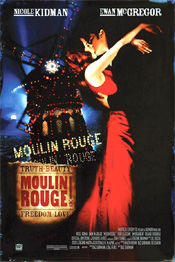
|
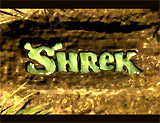
|
Shrek (2001)
d. Andrew Adamson/Vicky Jenson, 90 minutes, DreamWorks Animation
- DreamWorks Studios found the Shrek
franchise as
a way to successfully compete against dynamo Pixar and its feature-length
animated films in the early 2000s (with
Monsters, Inc. (2001) and Finding Nemo (2003)). It
led to three very successful sequels for the remainder of the decade: Shrek
2 (2004), Shrek the Third
(2007), and Shrek
Forever After (2010).
- The quasi-fairy tale animation invented an intriguing
title character - a reclusive, swamp-dwelling ogre named Shrek
(Mike Myers) who reluctantly went on a quest to save Princess Fiona
(Cameron Diaz) from a dragon-guarded tower, with the companionship
of Donkey (Eddie Murphy). It was designed to appeal to both children
and adults alike - with numerous pop cultural references, entertaining
songs, and laugh-out-loud humor.
- DreamWorks/PDI's subversive, revisionist fairy tale
was a biting satire and irreverent spoof of classic Disney animated
films, with fairy-tale in-jokes and lots of flatulence and subtle
sexual humor. The film's climactic final revelation, from Princess
to Creature, was an inverted "Beauty and the Beast" plot
element.
- With a production budget of $60 million, the influential
film had major box-office gross receipts of $268 million (domestic)
and $484.4 million (worldwide). It was the
third highest-grossing film of 2001, falling behind only the two
major franchises: Harry
Potter and the Sorcerer's Stone (2001) and The
Lord of the Rings: The Fellowship of the Ring (2001).
- It was the first animated film to win the Academy
Award for Best Animated Feature Film, a new category.
|
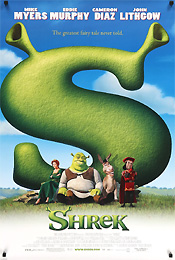
|
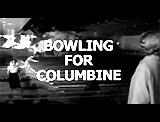
|
Bowling for Columbine (2002)
d. Michael Moore, 120 minutes, Alliance Atlantis/Dog Eat Dog Films/United
Artists
- Iconoclastic, sardonic, independent film-maker/journalist
Michael Moore has had varied success with his personally-made films
about the excesses and abuses of corporate America, social issues
and politics, but this one really struck the mark.
- Moore's provocative Bowling for Columbine
(2002), the Best Documentary Feature Academy Award-winner, presented
a critical look at the US's trigger-happy obsession with gun
rights, and the high rate of crime and violence in the US; it also
examined the US as an aggressor nation, with its institutionalized
violence, and the American culture of fear.
- The film was the first documentary to compete in
the Cannes Film Festival's main competition in 46 years, and was
the unanimous winner of the festival's 55th Anniversary Prize.
- It was also the first documentary film to be nominated
and then win the Writers Guild of America (WGA) Award for Best
Original Screenplay in 2003. It was also the highest-grossing documentary
of all time, soon to be surpassed by Moore's own Fahrenheit
9/11 (2004).
- Activist documentarian Michael Moore's
film contained interviews with pro-gun advocates, including a bizarre
James Nichols and members of the Michigan Militia (who counted Terry
Nichols and Timothy McVeigh of the Oklahoma bombings as members).
It also included a remarkable interview with NRA spokesman/actor
Charlton Heston at his home, who expressed his pro-gun position
only a few weeks after the Columbine (Littleton, Colorado) HS shooting
in April, 1999.
|
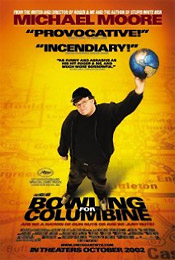
|
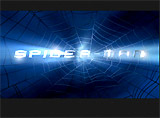
|
Spider-Man (2002)
d. Sam Raimi, 121 minutes, Columbia Pictures
- It was based upon the Marvel comic-book character
by writer Stan Lee. In many ways, this film ushered in or redefined
the modern era of superhero films (although it did come on the
heels of Batman,
Superman, and X-Men franchises).
- The film introduced
the popular character of geeky, bespectacled Midtown HS senior
Peter Parker (Tobey Maguire), who became a superhero vigilante
following a spider-bite. (Sam Raimi's follow-up sequel, Spider-Man
2 (2004) proved
that a comic book movie had staying power and could be both critically
and commercially successful.)
- At the time of its release, it was the highest-grossing
(domestic) superhero film of all time, but has now been knocked
down considerably.
- With a production budget of $139 million, the film
grossed $403.7 million (domestically) and $825 million (worldwide).
It was the No. 1 grossing film of 2002, and has remained the # 1 film
(domestic) of the entire Spider-Man
franchise (from
2002 to 2019).
|
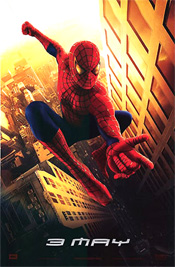
|
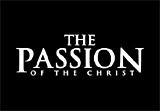
|
The Passion of the Christ (2004)
d. Mel Gibson, 127/120 minutes, Icon Productions/Newmarket Films
- Co-producer, co-writer, and director Mel Gibson's
R-rated, self-financed, independent smash-hit film, a brutal and
ultra-violent, blood-soaked depiction (or reinterpretation) of
Jesus' last 12 hours on Earth, stirred up considerable controversy.
The much-debated, controversial work was filmed with dialogue in
three languages (Aramaic, Hebrew, and Latin) - with subtitles.
Although Gibson claimed that the account was authentic and 'truthful'
- it would be nearly impossible to derive a strict and true historical
account of the events from the Gospels.
- The film went on to be the most successful and profitable
R-rated film ever, with $370 million US box-office (domestic) receipts
(on a budget of $30 million), mostly due to its embracing by evangelical
church groups and many faithful Christian believers. Many audiences
thought they were watching an accurately-portrayed vision
of Jesus' (Jim Caviezel) final hours with its visceral horrors
of flagellation, torture and crucifixion.
- It told of the agonizing, unsparing crucifixion
death of "Jesus
Nazareth/ King of the Jews" on the cross. He was first severely
beaten, forced to carry part-way his own wooden cross to the hillside
of Golgotha outside Jerusalem, and then was nailed to the cross to
suffer and die. The scenes were visceral, horrific to watch, and brutal,
although artfully portrayed with gorgeous cinematography and slow-motion
( in part).
- It set a number of records:
(1) the highest-grossing independent film of all time, (2) a record
number of pre-ticket sales, more than any other film in history,
(3) the highest-grossing R-rated film of all time, (4) the highest-grossing
(domestic) foreign-language film and/or subtitled film in history,
and (5) the highest-grossing (worldwide and domestic) religious (Christian)
film of all time.
- Due to intense criticism over its excessively graphic
scenes, an unrated, re-edited re-release of the film (still R-rated),
named The Passion Recut (2005), with Gibson's own edits (removal
of about 5-6 minutes of graphic violence, and toned down scenes of
the grisly acts of torture) was released and shown in theatres for
a short time in 2005.
- The scourging (a 10-minute sequence) and crucifixion
scenes in particular were overpoweringly graphic, bloody, torturous
and vicious. Even Gibson admitted that the film was deliberately "shocking" and "extreme" in
order to depict Jesus' enormous sacrifice.
- Even before it was released and viewed, religious
leaders were indignant over its Catholic-tinged interpretation
of the Bible, its use of extra-Biblical sources, and its poetic
license, and Jews protested the film as anti-Semitic - believing
that the "obscene" film
would blame Jews for the death of Jesus. Gibson had difficulty securing
a distributor for his film.
|
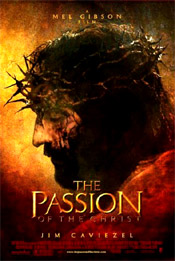
|
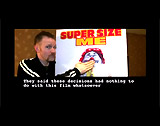
|
Super Size Me (2004)
d. Morgan Spurlock, 98 minutes, The Con/Samuel Goldwyn Films/Roadside
Attractions
- Writer/director/producer Morgan Spurlock's Oscar-nominated
documentary provided a scathing expose of the enormous influence
of the fast food industry and its disastrous effects upon one's
health due to its poor nutritional offerings. One of his concerns
was the rapid rise of obesity in US society. He decided to exist
on a diet solely of McDonald's menu items for about a month in
the spring of 2003, while being filmed. The film's subtitle was
"A Film of Epic Portions."
- At the time, the independent film - with a budget
of $65,000, grossed $11.5 million (domestic) and $20.6 million
(worldwide), and in 2022 was the 32nd highest-ranking US documentary
of all time.
- Super Size Me appeared just
before another similar film that examined the fast food industry
- director Richard Linklater's Fast Food Nation (2006), based upon the 2001 non-fiction novel authored
by Eric Schlosser. Linklater's ensemble drama followed fast-food
chain VP marketing director Don Anderson (Greg Kinnear) who discovered
that the hamburger used for Mickey's chain outlet in California
(for a signature best-selling sandwich known as "The Big One")
came from a processing and packing slaughterhouse
plant in Cody, Colorado (the local Uni-Globe company). Fecal matter
introduced into the meat at the plant was due to sloppy production
standards. A side theme was the exploitation of Mexican illegal
immigrants for the chain who became low-wage employees for the
company.
- The result of Spurlock's binge-diet (McDiet) was
that his health rapidly deteriorated during the 30 days of the
experiment, even while he was being constantly monitored by three
doctors. The 32 year-old Spurlock gained a significant amount of
weight (25 pounds) and experienced unexpected side effects from
the high-fat, high-cholesterol diet, including a large depletion
of energy and lethargy, loss of muscle mass, depression and mood
swings, some liver damage, and suppression of his male libido.
- Some critics decried the film as an unscientific
publicity stunt, and that Spurlock hadn't released his detailed
food-log for the month.
- The documentary raised awareness of the shocking
effectiveness of advertising used on children to buy the product
(the image of Ronald McDonald).
- As a result of the film, McDonalds discontinued
its Supersize Meal option from their menu selections within six
weeks, although the company denied that the film had any effect
upon its decision. McDonalds also began to provide a new healthier
menu, including salads, and a new adult Happy Meal.
|
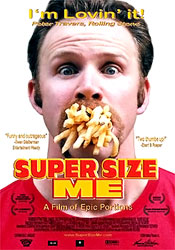
|
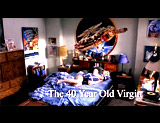
|
The 40 Year-Old Virgin (2005)
d. Judd Apatow, 116 minutes, Universal Pictures
- Writer/director Judd Apatow's R-rated, adult-oriented
sex comedy (his directorial debut) helped to bring realism and
life (through many improvised sequences and a well-written intelligent
script) in the wake of so many raunchy, gross-out and rude frat-boy
films of the early 2000s.
- At its heart was the sympathetic portrayal of the
title character - a loveable loser - an awkward and middle-aged
geek or man-child named Andy Stitzer (Steve Carell), an electronics
store clerk and toy hobbyist (with a large action-figure and comic
book collection) who was being counseled by his friends and co-workers
on how to lose his virginity.
- The most memorable and outrageous set-piece was
Andy's chest-waxing experience.
- The surprise coming-of-age hit was a critical and
commercial success, with a gross (domestic) take of $109.5 million.
|
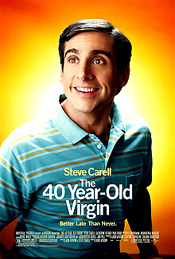
|
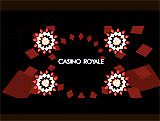
|
Casino Royale (2006)
d. Martin Campbell, 144 minutes, Columbia Pictures
- This was the 21st installment in the series, coming
at a time when the aging franchise needed a back-to-the-basics
reboot or reimagining (rather than a sequel or a prequel) with
a new Bond (following Pierce Brosnan's departure).
- The revitalizing, inventive film was
the first
of five films (through 2020) with Daniel Craig, portraying a more
macho, lean, mean, and direct James Bond (complete with an origin
story) - who also saw the tragic demise of his doomed, raven-haired,
green-eyed love interest Vesper Lynd (Eva Green). The serious action
film climaxed with a world-class poker game at
the Casino Royale in Montenegro.
- With a production budget of $150 million, and gross
revenue of $167.4 million (domestic) and $616.5 million (worldwide),
it became (unadjusted for inflation) the highest-grossing Bond
film of all time, even surpassing Craig's next film Quantum
of Solace (2008) at $589.6 million (worldwide). It kept the record
of highest-grossing (domestic) until the release of Skyfall
(2012).
- To be more realistic, the film relied more on a
smartly-written plot and character development and less on CGI
technology; it reduced the number of techo-gadgets and jokey one-liners,
emphasized real physical stunt-work, departed from long-held conventions
in Bond films, and cut back on the number of obvious product placement
advertising.
- In early 2007, it became the first Bond
film ever to be shown in mainland Chinese cinemas.
|
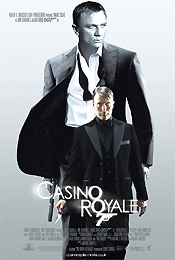
|
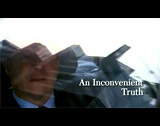
|
An Inconvenient Truth (2006)
d. Davis Guggenheim, 96 minutes, Lawrence Bender Productions
- This harrowing, thought-provoking, and earnest,
fact-based Best Documentary Feature Academy Award winner was about
the twin threats of global warming (climate change) and environmental
pollution. (It was followed by a sequel: An Inconvenient Sequel:
Truth to Power (2017).)
- At the time, the film, with a budget of $1.5 million,
grossed $24.1 million (domestic) and $49.8 million (worldwide),
and in 2022 was the 13th highest-ranking US documentary of all-time.
- The social-issues conversation was hosted by former
Vice President Al Gore (as Himself), now posing as an environmental
activist, whose opening line was: "I used to be the next President
of the United States of America." With a masterful use of
slides, animations, flow charts, computer graphs and 'nature' photos,
he delivered a multimedia lecture that he had delivered in-person
hundreds of times, to illustrate the disastrous results of global
warming via various man-made and climate-related disasters.
- Included in the
presentation was the short clip "Global Warming or: None Like
It Hot" from the animated TV show Futurama, taken from
a 2002 episode in which Gore guest-starred, about the effects of
greenhouse gases. His descriptions were illustrated by before-and-after
photographs of the effects of global warming on various landmarks,
such as the mountain peaks of Mt. Kilimanjaro, and on glaciers
at the poles.
- In one scene, he used a scissors-style fork lift
to raise himself up on the right side of a mammoth graphic to examine
annual temperature and the drastically high, rising rate of CO2
emissions levels for the past 650,000 years, measured by Antarctic
ice core samples. With demands for quick action, he delivered warnings
about the future of the Earth if his warnings weren't heeded to
save the planet from destruction. His sermonizing increased awareness
of the urgency of the issue of global warming, with suggestions
to reverse its effects by releasing
less CO2 and planting more vegetation to consume existing CO2.
- His ultimate conclusion was: "I don't really
consider this a political issue, I consider it to be a moral issue." The
closing credits included recommendations in answer to the question: "Are
you ready to change the way you live?"
- However, critics of the highly persuasive film argued
that the film was exploitatively alarmist and exaggerated, that
there were numerous factual and scientific inaccuracies in the
film, and differing and balanced viewpoints about climate change
were not given equal weight. A discussion of nuclear power
was entirely ignored in the documentary. Some also accused Gore
of promoting his own political-social views in anticipation of
running again for President in 2008.
|
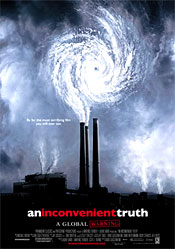
|

|
Avatar (2009)
d. James Cameron, 162 minutes, 20th Century Fox/Dune Entertainment/Ingenious
Film Partners
- Visionary director James Cameron's ambitious and
monumental work (his first feature film since Titanic (1997))
was this futuristic, epic, science-fiction/fantasy 3-D live-action
film, with ground-breaking, Oscar-winning special effects. It was
the first Best Picture nominee to be entirely filmed using stereoscopic
3-D technology.
- Reportedly
budgeted at over $237 million, the technically-ambitious and visually-stunning
film was ballyhooed for its incredible visual effects and 3D IMAX
presentation. Much of the visual effects masterpiece's reported
budget was spent on CGI. (40% of the film
was live-action, while 60% was photo-realistic CGI).
- It was the
highest grossing film at its time at $785.2 million (domestic), surpassing
his own Titanic
(1997) at $659.3 million (domestic), Cameron became the director
of the two biggest movies in film history, until later surpassed.
It also became the first film to gross more than $2 billion (its
worldwide revenue total was $2.78 billion).
- The 20th Century Fox blockbuster spectacle (a 'must-see'
film) had nine nominations, with three technical wins for Best
Art Direction, Best Cinematography, and Best Visual Effects (unusual
for a science-fiction film). Remarkably,
this was Cameron's first narrative film since Titanic (1997),
which had a record 14 nominations and 11 wins. No director had
ever attained a total of 23 total nominations in consecutive non-documentary
feature films.
- Although originally scheduled for release in late
spring of 2009, the opening was delayed until mid-December 2009,
due to the demands of the special effects, and the installation
of 3-D projection systems to accommodate the film worldwide. The film's
release spurred the installation of digital 3D projectors in US
theaters.
- It was a futuristic, sci-fi adventure-action
story about humans invading a fantastic planet inhabited by blue-skinned
aliens for its rare radioactive natural resource - unobtanium.
- Over a period of years, Cameron had designed dual-function
cameras that simultaneously filmed in both conventional 2-D and
state of the art 3-D. He devised a stereoscopic 'virtual
camera' allowing him to move through a 3D terrain during filming.
- The film also utilized cutting-edge motion performance-capture
assisted, photo-realistic CGI technology with actors on a stage
(called the Volume), to create the sympathetic Na'vi characters.
The technique of performance capture involved putting actors into
bodysuits covered with tiny dots, while about 140 digital cameras
captured their body movements. Another tiny helmet-rigged camera
was used for recording finer facial, eye, and head movements. And
then the digitally-recorded data was used by animators to create
the characters in their virtual world environment.
- "Avatar" started
a massive wave of studios requesting profitable post-production conversion
into 3D for their summer popcorn blockbusters (although the success
rate widely varied). The immersive 3D effect brought movies to
event-loving audiences, and substantially inflated ticket prices.
- It was reported that there would be a number
of Avatar sequels,
being filmed back-to-back. The first sequel was Avatar: The
Way of Water (2022), with a budget of $350 million.
|

|
